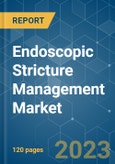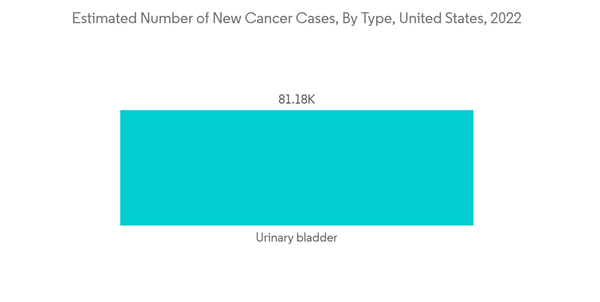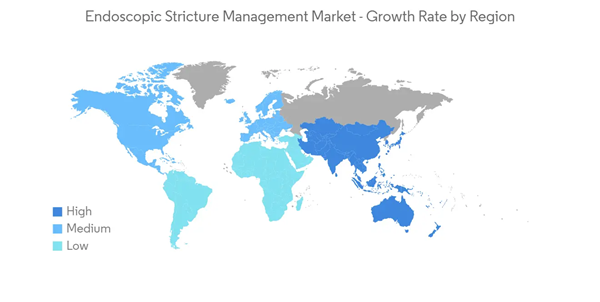The COVID-19 pandemic significantly impacted the market during the initial phase due to reduced surgical procedures. However, several stricture surgeries increased during the later stages of the pandemic. The research and development also increased related to stricture-related operations. An article published in Endoscopy International Open-access journal in January 2021 concluded that upper gastrointestinal (GI) stenting increased during the COVID-19 outbreak.
Additionally, as per another article published in the Cureus Journal in September 2021 during the pandemic, google analytics data showed an increased search trend for 18 terms, including urethral stricture. These instances show a demand for stricture management during the initial pandemic days, which is still growing, following various GI diseases. The sector has been recovering well over the last two years, which may lead to market growth in the post-pandemic era.
Factors such as the increasing geriatric population, a rise in the prevalence of GI disorders, new product launches with advanced technologies, and a preference for minimally invasive procedures are expected to fuel the market growth over the analysis period.
GI disorders are increasing globally. This creates the demand for endoscopic stricture management as strictures are commonly found in such diseases. For instance, the increasing colon cancer globally is one of the prime factors bolstering the demand for the prevention of colon stricture, which is a major cause of colon cancer. As per WHO's February 2022 update, colon cancer is one of the most common cancers in the population worldwide. An estimated 1.93 million new cases of colon and rectum cancers were reported globally in the year 2020. In addition, various sources show that in palliative and neoadjuvant settings, stenting is crucial in alleviating esophageal, gastroduodenal, or colorectal obstruction symptoms. Thus, endoscopic insertion of self-expanding metal stents (SEMSs) has a frontline application for managing malignant obstruction or stricture of the gastrointestinal tract (GIT). Thus, the demand for endoscopic stricture management is rising with increased colon cancer. This is expected to contribute to market growth during the analysis period.
Moreover, product launches, approvals, and other strategic activities by regional and global market players contribute to the overall market growth. For instance, in July 2022, Merit Medical Systems launched its pulmonary balloon dilator's most minor and shortest configuration. This new configuration helps physicians to safely dilate challenging strictures, including clogs in short airways, without fear of over-dilating past the intended site. Thus, the product launches are anticipated to fuel the market growth during the analysis period.
Therefore, the factors described above are expected to fuel the studied market growth. However, the lack of professionals with expertise in endoscopic stricture management and the high cost of GI endoscopic procedures are predicted to restrain the development of the market.
Endoscopic Stricture Management Market Trends
Stents Expected to Hold Significant Share
A stent is a flexible, self-expandable, hollow metal or plastic tube used to help open any obstruction in the gastrointestinal (GI) tract that any clog has blocked. Enteral stents are used to help the patient continue to eat or as a preparation for surgery. Also, developing GI stents relieves the symptoms of numerous disorders that clog the GI tract. Thus, owing to increased GI diseases globally and the advantages the stents provide, the use of stents is increasing. This is fueling segment growth.Corrosive upper gastrointestinal strictures (GIS) are common in children, and primarily accidental ingestion, commonly in younger children, contributes to the GIS. In these cases, stents are used. For instance, according to an article published in WJCP in November 2021, resistant caustic strictures are the most common indication of stent placement in children. In most cases, stents can be utilized along with endoscopic dilatation. Such instances increase the usage of stents for various indications. This is expected to contribute to the segment's growth over the forecast period.
Moreover, the technological advancements in the stents for better outcomes are anticipated to contribute to the segment's growth. For instance, in February 2022, Micro-Tech Endoscopy introduced the first self-expanding tracheobronchial nitinol y-stent. The Y-Shaped Tracheal Stent System's nitinol self-expanding construction and simplicity of use make it efficient at relieving patients with malignant tracheobronchial strictures. Thus, such development is expected to fuel the segment's growth.
Therefore, owing to the factors above, the segment is anticipated to witness significant growth over the analysis period.
North America Anticipated to Witness Growth in the Market
The North American endoscopic stricture management market is growing and is expected to do the same over the forecast period. The factors include the increasing geriatric population and the number of gastrointestinal (GI) disorders in countries across the region.The growing burden of GI disorders in the United States contributes to market growth. As per the 2022 report of the ACS, in the United States, 106,180 new cases of colon cancer and 44,850 new cases of rectal cancer are expected to be diagnosed in 2022. Also, as per the HHS 2022 update, 149,500 colorectal cancer cases were identified in 2021. This shows an increasing trend in gastrointestinal cancers in the country. In addition, as per the 2021 report of the International Foundation for Gastrointestinal Disorders (IFFGD), 25 to 45 million people were affected by irritable bowel syndrome with the disease in the United States in 2021.
In addition, GI disorders are also increasing in other countries, such as Mexico and Canada. For instance, as per the 2022 update by the Canadian Digestive Health Foundation (CDHF), nearly 20 million or more Canadians suffer from digestive disorders yearly. These gastrointestinal diseases are responsible for strictures in the GI tract, creating demand for the availability of stricture management devices. As endoscopic stricture management devices, such as balloon dilators, stents, and bougie dilators, provide better outcomes, the need for such devices is increasing in the United States. This is expected to contribute to the overall market growth in the region.
Moreover, the presence of most of the market players in the region's countries actively engaged in product development contributes to the growth of the studied market. For instance, in December 2021, Urotronic, Inc., a Minnesota-based medical device company, received approval from the Food and Drug Administration (FDA) for its Optilume Urethral Drug-coated Balloon for use in male urethral strictures. Optilume was granted CE mark approval for use in urethral strictures in 2020. Such product development is anticipated to fuel market growth in the region.
Therefore, the above-mentioned factors influence the market's growth and are expected to fuel market growth over the analysis period.
Endoscopic Stricture Management Market Competitor Analysis
The overall market for endoscopic stricture management is competitive, with many products available in the market. Most of the stricture management devices are majorly manufactured by the global key players. Market leaders with more funds for research and better distribution system have established their position in the market. Moreover, the market studied is witnessing the emergence of some small players due to the rise of awareness about the stricture and followed procedures. Some of the major players in the market are Boston Scientific Corporation, Olympus Corporation, Becton, Dickinson and Company, Cook Medical LLC, CONMED Corporation, STERIS, Medi-Globe Corporation, Hobbs Medical Inc., PanMed US, Merit Medical Systems, and Micro-Tech Endoscopy.Additional benefits of purchasing the report:
- The market estimate (ME) sheet in Excel format
- 3 months of analyst support
This product will be delivered within 2 business days.
Table of Contents
Companies Mentioned (Partial List)
A selection of companies mentioned in this report includes, but is not limited to:
- Boston Scientific Corporation
- Olympus Corporation
- Becton, Dickinson and Company
- Cook Medical LLC
- CONMED Corporation
- STERIS
- Medi-Globe Corporation
- Hobbs Medical Inc.
- PanMed US
- Merit Medical Systems
- Micro-Tech Endoscopy
- Laborie
Methodology

LOADING...










